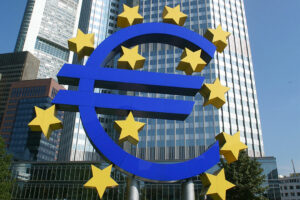FRANKFURT – The European Central Bank is all but certain to raise borrowing costs to their highest level in 22 years on Thursday and leave the door open to more hikes, extending its fight against high inflation even as the euro zone economy flags.
Growth across the 20 countries that share the euro is at best stagnating and inflation has been moderating for months, courtesy of lower energy prices and the steepest increase in interest rates in the ECB’s 25-year history.
Furthermore, the US Federal Reserve broke a string of 10 successive rate hikes late on Wednesday, a powerful signal for investors around the world that the current tightening cycle across developed economies is nearing an end, even if more US rate hikes are still likely.
But inflation in the euro zone is still unacceptably high for the ECB at 6.1% – more than three times its 2% target – and underlying price growth, which typically excludes food and energy, is only starting to slow.
That is likely to keep the ECB on the tightening path, particularly after it failed to predict the current bout of high inflation and began raising rates later than many global peers last year.
“They simply cannot afford to mess it up once again,” said Carsten Brzeski, the global head of macro at Dutch bank ING.
The ECB is predicted to increase the deposit rate – the interest rate banks pay to park cash securely at the central bank – for the eighth consecutive time, by 25 basis points to 3.5%, its highest level since 2001.
Economists polled by Reuters expect another move of the same magnitude in July before the ECB pauses for the rest of 2023.
ECB President Christine Lagarde is nevertheless expected to keep a further hike in September in play during her press conference on Thursday, and to push back against traders’ bets that the central bank will cut rates next year.
“We expect the ECB to leave the possibility of a terminal rate above 3.75% on the table and to encourage the market to price out some of the 2024 rate cuts,” economists at Deutsche Bank wrote in a note.
MIXED PICTURE
The ECB will update its economic forecasts, which are likely to put inflation closer to, but still above, 2% next year before it reaches the target in 2025.
While this would normally augur a pause in policy tightening, the ECB has been taking its own projections with a pinch of salt after years in which they missed the mark.
Instead, euro zone rate-setters have focused on actual economic data that has been painting a mixed picture.
Two quarters of contraction in industrial powerhouse Germany dragged the euro zone into a shallow recession last winter and the economy is likely to eke out only modest growth this year.
But unemployment is at record lows and wage growth is picking up, even if it still lags inflation.
Headline price growth has been falling fast after hitting double-digits late last year. But underlying prices, most notably for services, have yet to show the decisive drop ECB policymakers have said they would need to see before taking their foot off the monetary brake.
Higher borrowing costs are curbing demand for credit from households and companies as well as banks’ willingness to lend, but consumption is holding up well in nominal terms.
These opposing factors were likely to provide ammunition to both sides of the ECB’s Governing Council – the hawkish majority that has been pushing for more rate hikes and a minority of doves who have been advocating a pause.
As a result, economists expect the ECB to send out a more balanced message about the outlook than at recent meetings, when it stressed the need to raise rates further to cool demand.
“The ECB will probably emphasise even more strongly than before that its future policy path is data-dependent amid heightened uncertainty,” economists at Berenberg wrote in a note to clients. – Reuters

